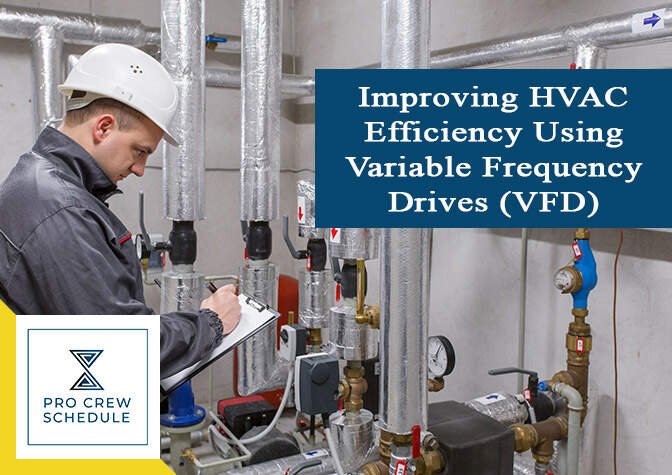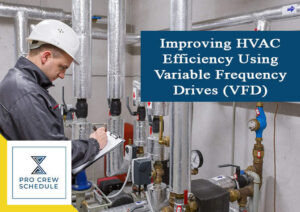H
VAC systems come in several configurations that differ significantly from each other. Variable frequency drives or VFDs have been utilized for HVAC systems in commercial buildings for more than 30 years. It is only recently that VFDs are installed to a growing number, driven by the advanced energy savings features. VFD technology has advanced rapidly over the years, and so as project management tools like crew schedule software. Both industry technologies offer great innovative benefits for HVAC technicians, particularly in improving systems, components, and handling projects overall.
Let’s begin exploring the different applications of Variable Frequency Drives in HVAC systems.
What is a Variable Frequency Drive?
VFD is a motor controller that drives electric motors by varying the voltage and frequency supplied to the electric motor. Frequency (hertz) has an immediate relation to the motor’s speed (RPMs). On the other hand, the faster the frequency, the RPMs are quick to go. If the application does not require any electric motor to operate at full speed, VFS can be used as a substitute to ramp down the voltage and frequency. The main goal of the process is to meet the requirements of the electric motor’s load.
Air conditioning systems that are based on packaged rooftop units are entirely not the same as a chiller plant. Yet, HVAC installations have the same denominator – they utilize electric motors directly subject to variable loads. Whether the engines are utilized to drive water pumps, compressors, and fans, there is still an excellent opportunity to save energy.
How Variable Frequency Drive (VFD) Exactly Work?
Let’s get first to electric motor speed, commonly defined by the power supply frequency and internal construction. VFDs are connected between the motor and power supply, adjusting frequency and voltage as a means of speed control.
In several applications where a single-phase power is only available, VFDs can be used as an alternative in incorporating three-phase motors while accomplishing energy efficiency benefits. Some models can produce three phases of voltage directly from a single-phase input while there are adjustments in frequency and magnitude.
Additionally, to improve energy efficiency, variable frequency drivers allow motors to be soft-started. The only effective way to have the motors become soft-started is to ramp up the frequency and voltage regularly. It should be opposed to the direct application of a full voltage at 60 Hz. Also, electric motors draw from five to ten times their standard current. The voltage drops the significant results from the inrush current, and it might damage any sensitive equipment.
VFD Applications in HVAC Systems
The performance of HVAC systems begins from the design phase. That is why managing construction projects and HVAC installations have to be a significant priority. In many cases, VFDs are often deployed in HVAC systems because of one goal – to control the speed of fans, compressors, or pumps.
1. Cooling Tower Fans
The major purpose of cooling towers is to eliminate the heat from water circuits, which might be used in turn for chiller plants or process cooling. Cooling towers often used fans to build an airflow and to improve heat removal by convection. These items are open discharge fans, where there was no ductwork producing resistance to airflow. Hence, the savings opportunity given by speed control is very significant.
When these variable frequency drives are already deployed for the cooling tower fans, speed is regularly controlled based upon the water temperature. Rather than cycling the fans on and off, it must be driven at minimized speed. By doing so, letting the process be kept at a consistent temperature is achieved. As explained previously, minimized-speed operations are far more efficient compare to intermittent operations at the fullest speed.
2. Package Rooftop Units and Air-handling Units
The items used in packaged RTUs and AHUs blow air directly into the duct system. It is very unlikely with the fans used for cooling towers. However, it requires a standard static pressure and offers higher resistance and airflow to be established successfully. The ducts might have plenty of outlets with VAV boxes or variable-air-volume. It is where airflow is controlled separately for every zone with dampers.
Without VFDs, the blower fans in the RTU and AHU usually operate at the fullest speed. Every VAV box is going to be adjusted individually. This approach might be insufficient, yet energy is still being wasted in the form of extra pressure if neither of the VAV boxes is entirely open. On the other side, if the blower is equipped with VFDs, an exciting energy-saving method becomes possible. Take a look below:
· The temperature from different and various zones is entirely unaffected. However, the pressure is minimized, and it saves more energy.
· Speed reduction continues nonstop until one of the VAV boxes had already reached the open position. It is not possible to lessen speed without affecting temperatures indoors at this point.
· There is also a control benefit when it comes to this control strategy. The minimized pressure drop often translates into reduced noise, turning indoor environments extra comfortable.
3. Chillers with variable-speed compressors
The chiller is by far the only piece of equipment having the highest energy consumption. Hence, it only means that installing the most effective chiller model is highly recommended. Energy-efficient chillers typically have helical rotary compressors. This type of compressor can adjust their speed using VFDs, depending on its cooling needs. Several models might feature multiple compressors to gain improved flexibility and to increase part-load efficiency.
A high-efficient chiller’s control strategy is based on maximizing its capacity rather than letting it run at lower possible set points. The savings are greatly achieved by lessening the load on the complementary systems. The system is far greater than the extra consumption at the chillers.
Speed Control for Water Pumps
One of the vital elements of an HVAC installation is water circuits; it includes the parts that used boilers, chillers, and water-source heat pumps. It usually is necessary to adjust the water flow varying on total system load since HVAC loads are already variable. Furthermore, below are the three main ways to accomplish it.
· Recirculation Valve – using this approach, a valve must be installed with a coextending recirculation circuit. It should be opened gradually to deter a significant part of the water flow, minimizing the main circuit’s flow. In this case, a considerable energy loss might occur because the circulated water is representing pumping power.
· Choke Valve – it is installed directly in line with the flow. Its name should imply it as it regulates flow by closing areas partially. This particular control method is so simple, yet the resulting pressure loss might represent a significant waste of energy.
· Pump Speed Control – installing a VFD directly on the pump motors is one of the most effective approaches. If a minimized water flow is required, it’s just a matter of lessening the pump speed properly. With no recirculation and pressure losses, the savings obtained are significant. This type of set-up also uses choke valves for extra convenience, yet it is commonly kept in an adequately open position because VFD regulates flow.
Integrating the Entire HVAC system
Equipping all motors of the HVAC system with variable frequency drives is the very first move towards energy-efficiency. However, the best results can only be obtained when fitted with a central control system. This system is capable of adjusting HVAC set points and assessing building conditions in real-time and circumstance. For HVAC technicians, using project management software is hugely beneficial now that being extra hands-on with projects and installations is crucial to the overall project success and completion.
Furthermore, the interaction between a cooling tower and a chiller is an excellent example of how VFDs and control engineering can be applied to HVAC installations:
· Lessing the fan speed of the cooling tower can increase the cooling load on the chiller
· The reverse also applies because minimizing refrigeration power at the chillers might require more heat to be eliminated by the cooling tower.
Also, if the chiller has higher efficiency, one great option in many cases is to reduce the cooling tower load. Nevertheless, only a particular control system can able to balance the operations of both components. Ideally, control systems must able to determine the setpoints for every individual VFD. The power consumption is then reduced at the total system levels.
How HVAC contractors manage a project?
When starting new HVAC projects and installations, there is a lot of pressure to manage and handle it. Project management and construction crew management are two integral aspects of any HVAC project’s success. Proper management is relevant and critical, from staying within budget, tracking project development, and improving collaboration and communication across crew members.
Implementing a project management tool is considered lucrative to ensure the completeness and development of a project. Contractors are also directly on top of the tasks, schedule, and budget every single time. They can effectively communicate and relate in all aspects of project development integral to the progress. Overall, software solutions for project management are a significant investment in any construction-related businesses.
Key Takeaways
VFDs are connected to more different motors other than an HVAC system due to the continuous energy savings. Today, the number of VFD applications continues to increase, specifically for commercial buildings. Even manufacturers are very consistent in developing new and advanced technologies.







